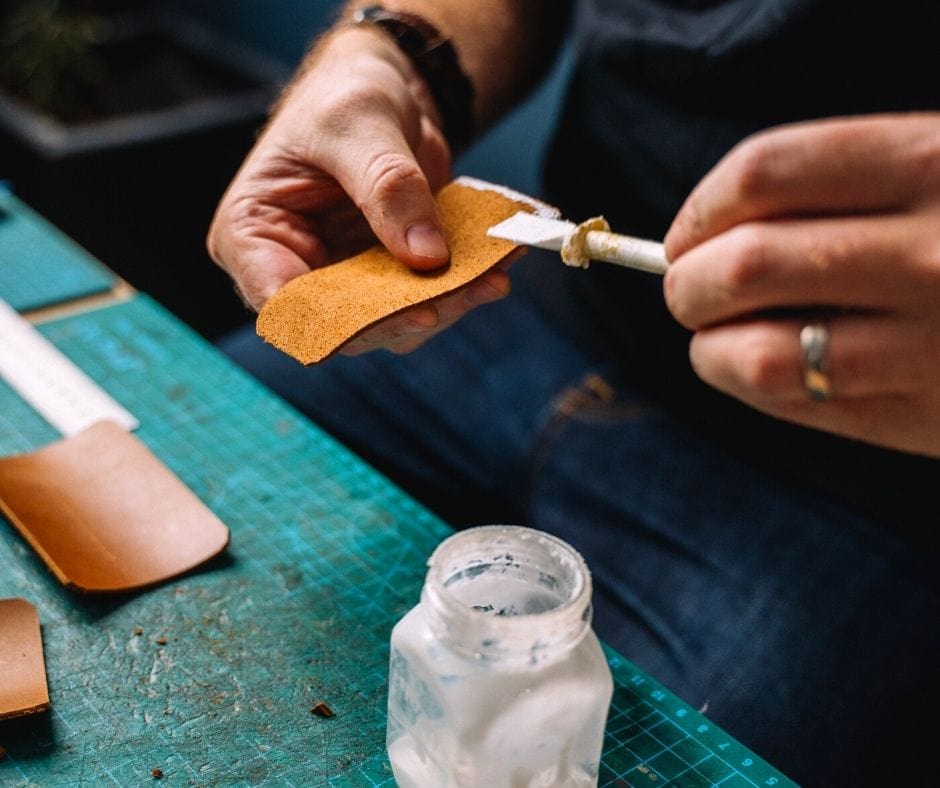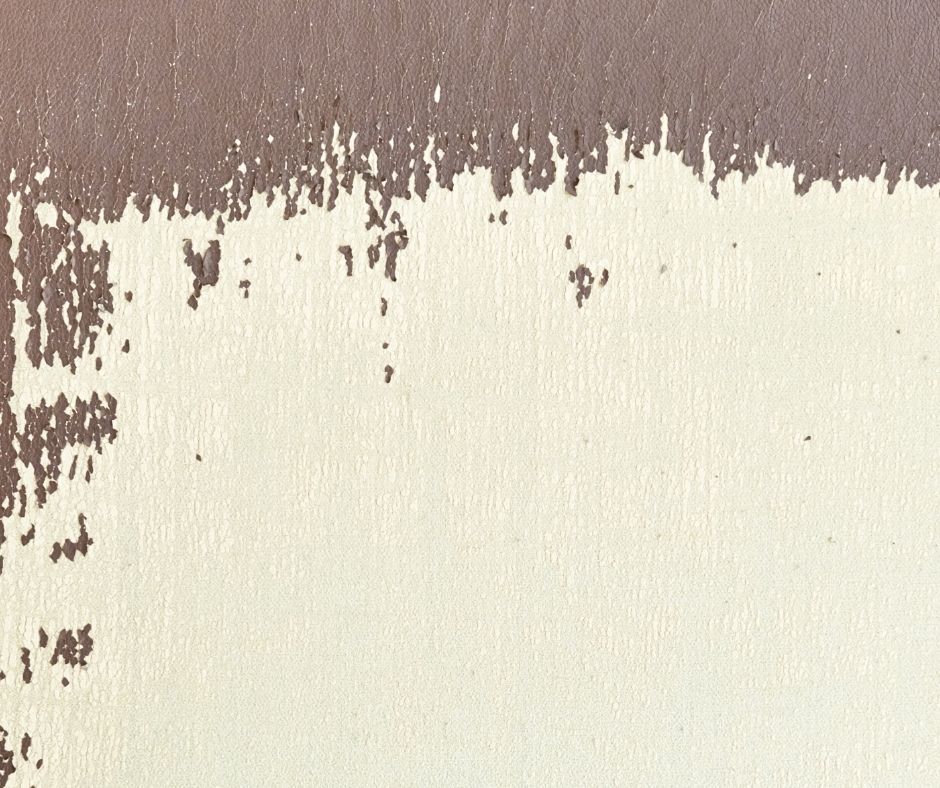Has your Vinyl couch started to peel? If you are looking for some DIY methods of fixing scratches or patching up holes, you’ve come to the right place.
In this article, I’ll take you through some of the best methods for getting your couch back up to pristine quality.
In This Article We'll Discuss
Identifying Your Problem
Vinyl is much less durable than other materials such as leather. Due to this, it frequently gets damaged. Between punctures, holes, and scratches, there are a lot of issues you can have with vinyl.
The first step to fixing any problem you have with your vinyl couch is identifying the size of problem. After that, decide if it is a rip or just a scratch.
If it’s a hole, keep reading. If you’re looking to fix some scratches, scroll down as I cover that later in the article.
How to Patch Small and Medium Holes in a Vinyl Couch
Smaller holes in vinyl couches are easily patched up. Follow the steps below and your couch will be good as new.
Step one – Create a Manageable Jole
The rip in your vinyl can take on any shape. In order to combat that, you’re going to want to shape the hole. Use scissors and make your hole a square shape. This will be the easiest shape to patch up.
Try not to make the hole much bigger, just trim the rougher edges. This will leave you with an easier area to work with. Doing this will lead to a much cleaner, and more natural, fix.
Step Two – Measure
Once you have a well shaped hole, you need to measure it. Measuring lets you know exactly how much material you’re going to need to cover the hole.
Use a ruler or a tape measure and write down the size hole your couch has.
Step Three – Off to the Store

Once you know the size of the patch you’re going to need, you can go to the store for materials. At the store, you’re going to want to find the right color patch. Patches come in all shapes and sizes, so have a browse until you come to one that matches your own.
A bonus tip is to take a printed photograph of your couch to the store. By placing this next to the patch shades, you’ll be able to find out if they match. You can also then ask someone who works at the store for help with locating the right color.
Don’t worry if you can’t find the right patch color. Simply buy a white patch color and then use a fabric dye to change the color to whatever you need. Vinyl colorant is cheap and easy to come by. A small amount goes a long way with colorant, so one purchase will last you a long time.
Make sure the patch you buy is at least one inch larger than your rip. This will ensure that the patch can completely cover the hole. The more the merrier, you don’t want to run out of material.
Step Four – Patching the Hole
Once you’re home, place the patch you’ve bought under the hole. Tuck the patch slightly behind the hole and align it. Make sure it is smooth and of the right size. You can trim down the patch you’ve bought if it is far too big.
You want your final product to fit smoothly behind the vinyl. If it’s too big, it will crumple and look strange. However, if its too small, you won’t be able to cover the hole.
Step Five – Adhesive

Apply fabric adhesive to secure the patch to the vinyl couch. You could also use a small amount of adhesive tape, although that is not the preferable method. Make sure to push down to secure the adhesive.
Step Six – Wait Till Dry
The adhesive can take up to 24 hours before it will dry. There is nothing worse than not waiting quite enough and ruining the placement. Your best bet will be to wait a full 24 hours.
In this time, you’re going to want to avoid any contact with heat or direct sunlight. A heated-up adhesive may lead to it becoming unstuck and ruining your placement.
Step Seven – Clean
At this point, your patch will have expertly covered the hole. However, one final step to finishing the job is cleaning it up. There may be some messy bits of adhesive still left on the sofa. Take a non-abrasive cloth and dip it into cold water.
Take that cold water sponge and gently rub in circular motions. This will clean up the patch and leave it looking fantastic.
How to Patch Large Holes in a Vinyl Couch
If you have a severe rip in your couch, you’ll still be able to fix it. First of all, put all of the stuffing that has fallen out back inside the hole. You’re going to want to pack as much lost fabric as possible.
Mentally split the rip into sections. Using the above steps, you can then start to cover little bits of the rip. Each one will build upon the last fix, becoming a lattice of patches. Although this may look messy at the start, it is the best way to fix the hole.
Once you’ve added patch after patch until the hole is full, get ready to clean. First of all, fill the area with dye filler, this will bind the pieces together and give it a smoother finish.
Once you have applied dye filler, wait for it to dry. This can take around 6 hours to be completely done. When this has finished, use a cloth to buffer the area. You’re going to want to slowly sand down the area until it has a smooth tone. Once the area looks cohesive, apply more dye.
You will now have patched up the hole and dye the area back to the correct color.
Considering the size of your hole, this can be more expensive. A tip to offset this is to buy a large amount of white vinyl patch. You can dye that to be whatever color you need.
Why is my Faux Leather Couch Peeling?

It’s completely normal for your faux leather couch to start peeling. This isn’t always to do with bad handling, it’s just a fact of having vinyl. The material isn’t particularly durable, meaning it often can rip and fray.
Peeling will happen with increased friction, so around your seating positions. These tiny cracks will eventually come together to form larger scratches. Be careful to not sit down with keys in your pocket.
A sharp point, like that of a key, can pierce the vinyl and create lasting damage.
Vinyl couches will also start to peel over time. If you want to slow this process, there are two things you can do. First of all, keep the couches out of direct sunlight. Similarly, keep them away from open sources of heat. Fires and wood burners will dry out the material, leading to it being less durable.
How do you Get Scratches Out of Vinyl Upholstery?
The best technique for getting scratches out of vinyl upholstery is to use a DIY kit. These are readily available on amazon. They come with cloths, repair compound, and alcohol pads.
First of all, dampen a cloth in cool water and clean the area. Try and wipe this dry afterwards, so the area has no moisture left.
Take an alcohol pad from the kit and wipe it over the area. Then spread the repair compound over all of the scratches.
Dip your finger in water and smooth down the compound. Let this dry for around an hour. Get another alcohol pad and smooth out the compound from the top. This will solidify the fix into the vinyl.
Next, paint a clear coat onto the area. This will create a glossier finish and cover the color of the scratches.
Finally, cover the area in a little bit of vinyl conditioner. Although this step is optional, it really does help the final quality of the fix.
How to Get Scuff Marks Out of a Vinyl Couch
If you’re looking to get rid of tiny scuff marks, you should have everything you need in your home. You’re going to want to find a pencil eraser. The one on the end of a pencil is completely fine.
Damp the eraser, and then simply try to rub out the scuff marks. The combination of the eraser and the water will fade the marks.
If that doesn’t work, sprinkle the area with baking soda. Leave that for around a minute and then repeat the process with a wet sponge. That should get rid of any final marks.
How to Hide Parts of a Peeling Leather Couch
The two best ways to hide peeling parts of a leather couch are through blankets and cushions. Depending on the location of your peeling leather, either of these should cover the area.
If the peeling is on the seating area, place a cushion on top of it. Similarly, draping a blanket over the area will completely hide any peeling. This can also bring a level of comfort to the vinyl couch.
Conclusion
If you’re looking to repair a vinyl couch, you’re going to need some supplies. You can dye white patch material to whatever color you need.
Alternatively, you can pick the exact color patch you need from the store. A little bit of adhesive glue and you can attach the patch and the couch.
This will connect the couch and the patch, leaving you with a hole-less couch. Clean the area with a little water and you’re good to go.

